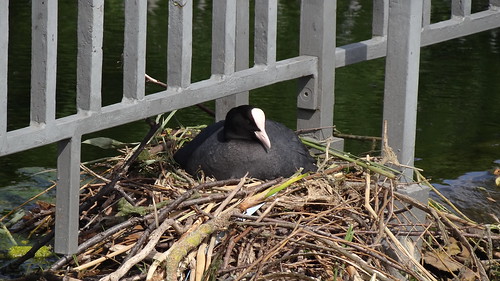Just between you and me, coots aren’t the nicest birds in the world. Even when they’re not busy drowning each other’s chicks and dueling to the death on park ponds and puddles, they’re fractious beasts, their squawks and rattles breaking the palustrine peace wherever they’re found.
Curious about whether these asocial behaviors have always defined cootness, I cast a quick glance at some of the older literature treating these familiar birds. “Older”? Yes, a lot older: The works listed in the zoological index to the Patrologia latina, always a convenient, if rarely a comprehensive, way to begin to answer questions like this.
Isidore of Seville’s account of the fulica, dating to the first quarter of the seventh century, begins with an inscrutable etymology: The coot is called “fulica” because its flesh tastes of rabbit. (Migne proposes that the original reading was “fuliginem” rather than “leporinam,” thus rendering the taste “sooty” or “smoky” rather than bunnyish.) Isidore is on firmer ground (the birds aren’t) in the few natural history details he offers:
“This is a marsh bird, nesting out in the middle of the water or in the rocks around the water. It prefers deep water, but when it senses a storm coming on, it retreats into the shallows.”
In his encyclopedic De universo, composed two centuries later, Hrabanus Maurus adds a description of the bird, which is “gentle and black, smaller than a duck but with a similar body shape.” Hrabanus goes on to quote Isidore on coots’ fleeing an approaching storm for comforting waters, a behavior he likens to that of “those about to be baptized.” Adopting a variant reading of the “heron’s house” of Psalm 103, Hrabanus transforms it into a coot’s nest, the sacred font that leads all Christians into the kingdom of heaven.
Definitely in bonam partem.
In the latter half of the fourth century, Ambrose of Milan had been just as positive, finding in the coot a model of charity. Whereas eagles sometimes cast their young from the nest, “there is a bird called fulica, which gathers the rejected eagle chick unto its own young, and joining it to its own, it raises it with the same eagerness and feeds it the same food as it does its own brood. … We humans, however, sometimes reject even our own kind with savage cruelty.”
Hugh of St. Victor, or an author using the great scholar’s name, writing in the first half of the twelfth century, is even more enthusiastic about the coot as exemplar. This “quite intelligent bird, the wisest of all,” disdains carrion, and rather than flying around all over the countryside, it remains in one place, where it finds its food and its rest. (Pseudo-)Hugh deduces a lesson:
“So too does the faithful man live according to God’s will. Neither does he flit hither and thither, wandering from place to place as heretics do. He finds no delight in earthly desires and bodily pleasures, but just like that bird that eats no flesh, he remains and finds rest in a single place, that is to say, the catholic apostolic church…. Here he has the daily bread of immortality, and his drink is the priceless blood of Christ.” Hugh’s quoting Isidore on the coot’s nesting habits at the end of his account seems a mere afterthought.
It’s not much of a sample, true, but it’s enough to convince me that the coot–in spite of its sinister plumage, its raucous voice, and its all too public boisterousness–managed to avoid darker associations in the exegetic literature. A quick glance at the bestiary tradition, which is after all based largely in those sources, finds the pattern surviving through the Middle Ages: no devils, no sinners, no heretics.
But now I wonder about the emblem books….




